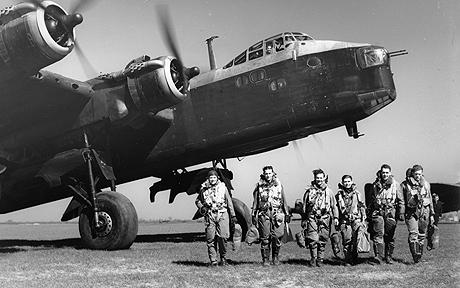The 7 Sqdn left from Oakington at 1943-07-30 at 22:12. Loc or duty Hamburg
He flew with a Short Stirling (type III, serial EF364, code MG-X).
Campaign report of the USAAF:
(Eighth Air Force): VIII Bomber Command Mission Number 80: The aviation industry at Kassel, Germany is targetted for today: 1. 119 B-17's are dispatched to the Bettenhausen Fieseler Works; 94 hit the target at 0910-0917 hours; they claim 40-7-29 Luftwaffe aircraft; 6 B-17's are lost, 5 are damaged beyond repair and 64 are damaged; casualties are 11 KIA, 10 WIA and 52 MIA. 2. 67 B-17's are dispatched to the Waldau Fieseler Works; 40 hit the target at 0925-0928 hours; they claim 8-6-3 Luftwaffe aircraft; 6 B-17's are lost and 18 are damaged; casualties are 1 WIA and 45 MIA. 107 P-47's with auxiliary tanks escort these raids and they surprise the attacking Luftwaffe fighters over Bocholt, Germany as the enemy is not yet accustomed to fighter escort penetration beyond the coastal fringe.
They claim 25-4-8 Luftwaffe aircraft; 7 P-47's are lost and 1 is damaged beyond repair; casualties are 6 MIA. VIII Air Support Command Mission Numbers 10A and 10B: 2 airfields are targetted: 1. 24 B-26B's are dispatched to the Woensdrecht Airfield, The Nether- lands; 11 hit the target at 0657 hours; 1 B-26 is lost, 1 is damaged beyond repair and 5 are damaged; casualties are 7 WIA and 6 MIA. 2. 24 B-26B's are dispatched to the Courtrai/Wevelghem Airfield, France but the mission is recalled because the escorting fighters are fog bound on the ground. In the 2 B-26 missions, the B-26 crews claim 6-5-1 Luftwaffe aircraft.
Campaign report of the RAF:
29/30 July 1943
The Battle of Hamburg continued with 777 aircraft - 340 Lancasters, 244 Halifaxes, 119 Stirlings, 70 Wellingtons, 4 Mosquitos being despatached. The marking for this raid was again all by H2S. The intention was to approach Hamburg from almost due north and bomb those northern and north-eastern districts which had so far not been bombed. The Pathfinders actually came in more than 2 miles too far to the east and marked an area just south of the devastated firestorm area. The Main Force bombing crept back about 4 miles, through the devastated area, but then produced very heavy bombing in the Wandsbek and Barmbek districts and parts of the Uhlenhorst and Winterhude districts. These were all residential areas. There was a widespread fire area - though no firestorm - which the exhausted Hamburg fire units could do little to check. 28 aircraft - 11 Halifaxes, 11 Lancasters, 4 Stirlings, 2 Wellingtons - lost, 3.6 per cent of the force.
4 Mosquitos to Düsseldorf, 6 Wellingtons minelaying in the River Elbe, 9 Lancasters of 617 Squadron dropping leaflets over Italian cities, 3 OTU sorties. No aircraft lost.
30/31 July 1943
273 aircraft - 95 Halifaxes, 87 Stirlings, 82 Lancasters, 9 Mosquitos - were dispatched to the previously unbombed town of Remscheid on the southern edge of the Ruhr; only 26 people had been killed in Remscheid, by stray bombs, in the last 3 years. This raid marks the true end of the Battle of the Ruhr. 15 aircraft - 8 Stirlings, 5 Halifaxes, 2 Lancasters - were lost, 5.5 per cent of the force.
8 aircraft laid mines in the Frisian Islands without loss.
With thanks to the RAF and USAAF.net!
This record can also be found on the maps of Back to Normandy with Google coordinates. You can find the maps by clicking on this link on this location.
There are several possibilities to investigate the flight records on Back to Normandy. All the flights are plotted on maps, sorted "day by day", "by squadron", "by type aircraft", "by year or month", "by location" and much more! Don't miss this!!!
If you have any information that you want to share, please add your comment at the bottom of this record. Or send your information to [email protected]. This information will be added to the record.
Your photos and your information are very welcome! The young do care and with your help we keep up the good work.



